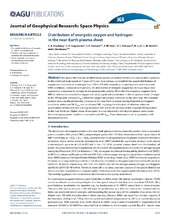| dc.contributor.author | Kronberg, Elena A. | |
| dc.contributor.author | Grigorenko, Elena | |
| dc.contributor.author | Haaland, Stein | |
| dc.contributor.author | Daly, Patrick W. | |
| dc.contributor.author | Delcourt, Dominique C. | |
| dc.contributor.author | Luo, Hao | |
| dc.contributor.author | Kistler, Lynn M. | |
| dc.contributor.author | Dandouras, Iannis | |
| dc.date.accessioned | 2016-03-10T14:08:11Z | |
| dc.date.available | 2016-03-10T14:08:11Z | |
| dc.date.issued | 2015-05 | |
| dc.Published | Journal of Geophysical Research - Space Physics 2015, 120(5):3415-3431 | eng |
| dc.identifier.issn | 2169-9402 | en_US |
| dc.identifier.uri | https://hdl.handle.net/1956/11606 | |
| dc.description.abstract | The spatial distributions of different ion species are useful indicators for plasma sheet dynamics. In this statistical study based on 7 years of Cluster observations, we establish the spatial distributions of oxygen ions and protons at energies from 274 to 955 keV, depending on geomagnetic and solar wind (SW) conditions. Compared with protons, the distribution of energetic oxygen has stronger dawn-dusk asymmetry in response to changes in the geomagnetic activity. When the interplanetary magnetic field (IMF) is directed southward, the oxygen ions show significant acceleration in the tail plasma sheet. Changes in the SW dynamic pressure (Pdyn) affect the oxygen and proton intensities in the same way. The energetic protons show significant intensity increases at the near-Earth duskside during disturbed geomagnetic conditions, enhanced SW Pdyn, and southward IMF, implying there location of effective inductive acceleration mechanisms and a strong duskward drift due to the increase of the magnetic field gradient in the near-Earth tail. Higher losses of energetic ions are observed in the dayside plasma sheet under disturbed geomagnetic conditions and enhanced SW Pdyn. These observations are in agreement with theoretical models. | en_US |
| dc.language.iso | eng | eng |
| dc.publisher | Wiley | en_US |
| dc.rights | Attribution CC BY-NC-ND | eng |
| dc.rights.uri | http://creativecommons.org/licenses/by-nc-nd/4.0/ | eng |
| dc.title | Distribution of energetic oxygen and hydrogen in the near-Earth plasma sheet | en_US |
| dc.type | Peer reviewed | |
| dc.type | Journal article | |
| dc.date.updated | 2015-12-29T14:31:33Z | |
| dc.description.version | publishedVersion | en_US |
| dc.rights.holder | Copyright 2015 The Authors | en_US |
| dc.identifier.doi | https://doi.org/10.1002/2014ja020882 | |
| dc.identifier.cristin | 1256448 | |
| dc.subject.nsi | VDP::Matematikk og naturvitenskap: 400::Fysikk: 430::Rom- og plasmafysikk: 437 | |
| dc.subject.nsi | VDP::Mathematics and natural scienses: 400::Physics: 430::Space and plasma physics: 437 | |

